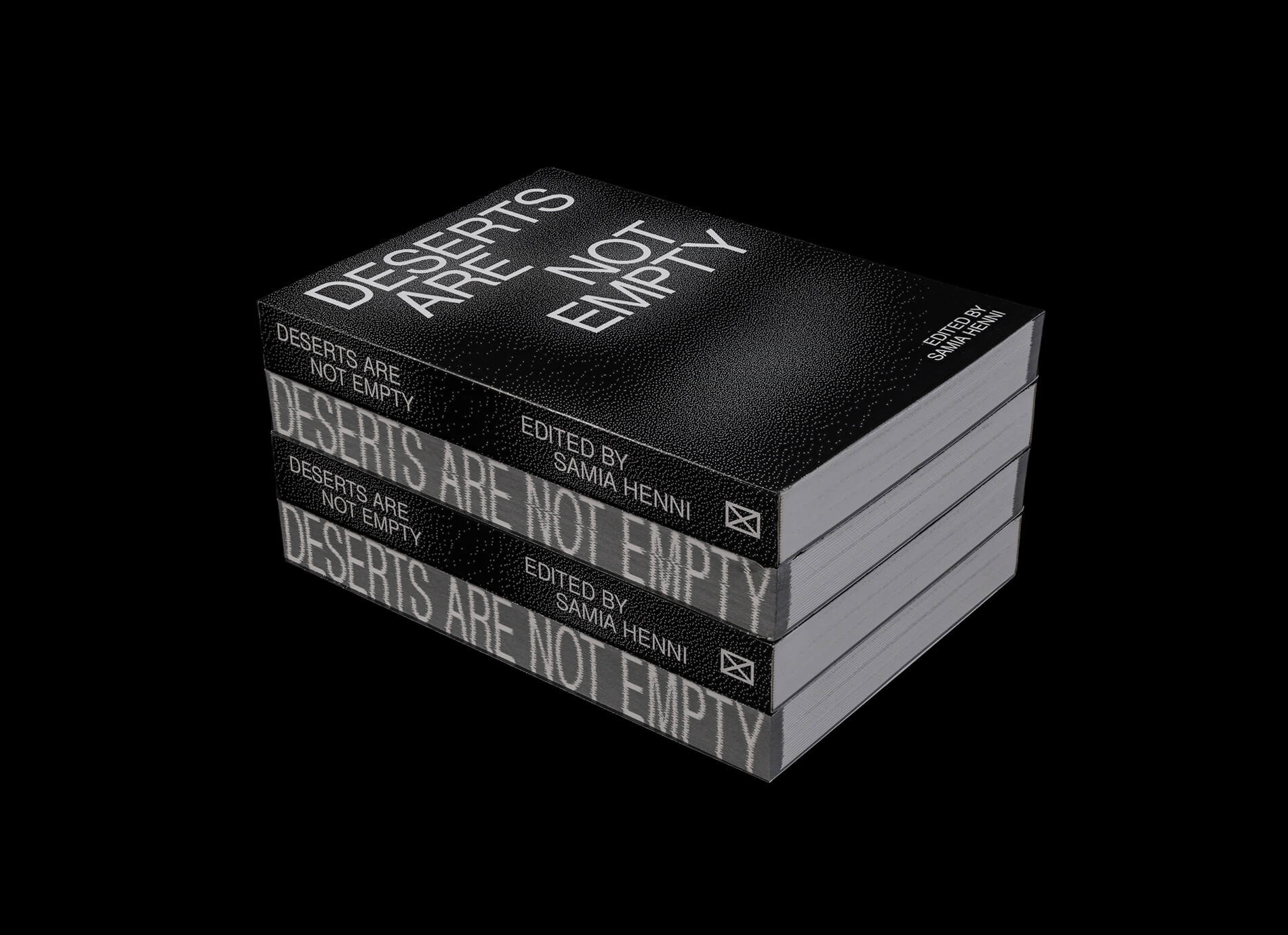Deserts Are Not Empty
Edited by Samia Henni | Columbia Books on Architecture and the City | $23
In December 2022 and January 2023, Deserts Are Not Empty accompanied me over the course of, and between, three road trips in Saudi Arabia. The first was a five-hour drive from the desert island of Bahrain to Riyadh to see The Line Exhibition. The drive is a straight shot westward through the desert along a sandy-gray asphalt road, a four-hour gradient moving gently upward from the Eastern Province’s dusty white, trash- and tire-studded landscape to the orange sands that bound the Tuwaiq escarpment. The book remained in the car as we entered a giant warehouse in Diriyah converted into an expensive presentation of the NEOM project under construction in northwestern Saudi Arabia where the desert meets the Red Sea.
The second road trip was around ’Asir, a mountainous region where the Hijaz Mountains break into the younger peaks of the Sarawat and continue south into Yemen. “Mountain people are different from desert people,” a native of Abha, the province’s capital, explained as we drove around ’Asir’s stepped terraces. Another passenger from the Arabian Gulf followed up, noting that when it rains over the Hijaz Mountains, the water slips through the fissures in the mountains and slowly trickles east beneath the desert, replenishing aquifers that sustain life in the cities of the Gulf. “Ah, so we both drink the same water; you just get it much later,” the Abha native teased.
I finished the book on the third road trip, from Bahrain to Al Ahsa Oasis. The UNESCO site in Saudi Arabia is one of the world’s largest oases. I was there to meet an Al Ahsa native, artist Mohammed Al Faraj, and to see the end of the annual rice harvest. Hassawi red rice is unique to Al Ahsa and requires temperatures over 100 degrees Fahrenheit to grow properly. I read Timothy Hyde’s essay about Antarctica while we were driven out of the oasis nestled between palm groves and rice fields. Soon we were surrounded by desert in all directions. The dunes around us were desolate, empty of people, birds, and plants, but also full of truck tires, plastic bags, abandoned vehicles—the residue of an oil economy emanating from the oil fields nearby. On one hand it is not empty, but without context its fullness might not seem meaningful, beyond the fallout of the oil boom.

I belabor the personal context of reading Deserts Are Not Empty not to legitimize this review as a text prepared by someone who lives in a city in a desert region or as someone who has been to deserts. Rather, it’s worthwhile to articulate where, when, and to whom such a book might be operative by suggesting three of several possible points of entry into it, each seen from the perspective of one of the aforementioned trips: One was entering the book as someone curious about new and ongoing developments in the desert; the second, as perhaps a tourist looking to make sense of the encounter with deserts and what they may mean or how to think of them as conceptual sites first and physical sites second, where they begin and end; and the third, as someone looking to understand the desert as a body of personal and communal knowledge and to find frameworks for parsing that knowledge and locating it within a specific place and ecology.
Staging points of entry to Deserts Are Not Empty is not a way of suggesting an audience and thus evaluating the book’s merits based on what an (imagined) public might think. Rather, the act is more a way of understanding the positions (and larger body of literature) the compendium sets itself against.
It is timely that Deserts Are Not Empty, a collection of contributions edited by architectural historian Samia Henni, comes amid a resurgent exploration of deserts in architectural discourse. This occurs both through a renewed interest in land art, site-specific works, extraction, and ecology in academia—and through a set of publications released or forthcoming in the U.S. and Europe: publications like Manual for a Future Desert, the “Notes on the Desert” section in Log, and the JAE 77:2 Deserts issue, which have been released or will be released in the past or next year or two. Additionally, built and under-construction projects like The Line in Saudi Arabia, the Tesla Gigafactory in Nevada, and solar power stations in North Africa suggest an urgency to intellectualize the architectural efforts happening in deserts globally. Global climate change and desertification—crises that require the rethinking of food, farming, and growth—also make the desert an expanding and moving condition around the world.
Before one reads its contents, the book’s layout sets the tone for what is to come. Designed by Laura Coombs, its black cover is speckled with pixels of varying density, mimicking desert sands, its map-fill equivalent, or particulate matter in the atmosphere. The use of printed edges is reminiscent of Irma Boom’s designs for OMA’s publications. The similarity distances it from academic journals and lands it among more speculative collections like AMO/Rem Koolhaas’s Countryside, A Report, another recent publication exploring broader territorial questions and articulating stances through an assemblage of images and essays.
Deserts Are Not Empty begins with Henni introducing the larger themes at play in the various essays. The text doesn’t tease the essays to come but instead provides a case study that hints at the second theme (or a suitable subtitle) of the book. Titled “Against the Regime of ‘Emptiness,’” the chapter narrates the designation of the desert as an empty space by the French colonial regime in the Sahara. While the chapter “invites the reader to subvert the analysis of the conceptualization of the desert,” the chapter—and much of the book—doesn’t reconceptualize the desert as a physical entity but actually dismantles the notion of emptiness as a colonial construct and thus the desert as a stand-in or designator for territory ripe for exploitation.
The publication is composed of interviews, poetry, mappings, and essays that range from the academic to the prosaic. Early essays and contributions by Ariella Azoulay on the Negev/Naqab and Paulo Tavares on the sertãos of Brazil push back against the propagation of emptiness as a political exercise in controlling and exploiting new territories. Essays by the Desert Futures Collective and Menna Agha and an interview with the 2020 Venice Biennale Kuwait Pavilion team articulate the desert as a space of personal narratives and local histories, complementing mappings and drawings with stories, poems, and illustrations. Later, Danika Cooper, Dalal Alsayer, and XQSU reveal the desert as a space of intervention and planning, where tools are invented for the mapping, conquest, and design of a territory. Contributions by Tavares, Alla Vronskaya, and Timothy Hyde expand the notion of the desert, pushing it beyond a geological or climatic condition to include the rain forest, Mars, and Antarctica, respectively, ultimately pointing to the notion of the desert as a larger idea of emptiness and a lack of inhabitation separate from a strict climatic definition.

As a set, the contributions span a wide intellectual and geographic realm. At times, the volume risks venturing almost into a kind of geographic solipsism. The need to decouple the desert from nothingness/emptiness while also repudiating the notion of emptiness shifts the focus from the desert as a place to the question of nothingness as a broader intellectual question. In its best moments the book uses deserts as case studies for understanding emptiness as an ideological, academic, and spatial narrative. In those moments Deserts Are Not Empty is a terrific compilation of essays that allow us to rethink how the desert has been transformed from an actual condition to an idea in service of extractive politics. It provides a sufficient range of desert conditions to be a body of arguments against a global condition and will prove useful to readers outside built-environment professions when they think through landscapes of colonialism and the possibilities of their decolonization.
Deserts Are Not Empty informs a reader that the desert is full of geological, historical, and ecological content. While it doesn’t suggest possibilities for how one could fill the desert, it does intervene in the knowledge and political regimes that ascribe emptiness to underutilized and underexploited territory. Where it is less operative is in offering an alternative to the travel fictions and exploratory prose of figures like Reyner Banham or Robert Smithson. Henni’s volume is not a substitute for those books, but a complementary addition; it points out their limitations. In a moment when those texts are experiencing a resurgence of interest, Deserts Are Not Empty reminds us of the shortcomings of that body of work and even land art more broadly. These places can no longer serve as abstracted intellectual landscapes approached with measured indifference to their particular histories. Henni’s volume reminds us that there remains a need for methodologies to deal with the desert not as an idea but as a network of actual places to be dealt with in specific and individual ways.
In November 2022, Henni’s office at the Cornell University College of Architecture, Art, and Planning was broken into and vandalized. An open letter written in support of Henni was circulated asking for the findings of the police investigation to be made public, as its authors believed the break-in was a response to the lecture “Palestine is There, Where it Has Always Been” that she convened at Cornell as part of the lecture series Into the Desert: Questions of Coloniality and Toxicity. Despite the open letter and petition’s having over 1,000 signatures, the Cornell University Police Department did not share any information from its investigation. This incident is a reminder that the desert is not only decidedly not empty but still a subject of active and ongoing political attention. The topic is subject to the designs of political-colonial or capitalist-industrial regimes. The publication and Henni’s teaching point to the reality that the desert is a contested and politicized space. Rethinking it is not without urgency, but the act is also not without the possibility of reprisal.
Ali Ismail Karimi is an architect whose work explores public space, ecology, and the extractive landscapes of the Middle East. He is the cofounder of Civil Architecture, an architecture office based in Manama, Bahrain, and Kuwait City, Kuwait.











